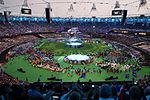The opening ceremony of the 2012 Summer Olympics took place on the evening of Friday 27 July 2012 in the Olympic Stadium, London, during which the Games were formally opened by Queen Elizabeth II. As mandated by the Olympic Charter, the proceedings combined the ceremonial opening of this international sporting event (including welcoming speeches, hoisting of the flags and the parade of athletes) with an artistic spectacle to showcase the host nation's culture. The spectacle was entitled Isles of Wonder and directed by Academy Award-winning British film director Danny Boyle.
Prior to London 2012 there had been considerable apprehension about Britain's ability to stage an opening ceremony that could reach the standard set at the Beijing Summer Games of 2008. The 2008 ceremony had been noted for its scale, extravagance and expense, hailed as the "greatest ever", and had cost £65m. In contrast, London spent an estimated £27m (out of £80m budgeted for its four ceremonies), which was nevertheless about twice the original budget. Nonetheless, the London opening ceremony was immediately seen as a tremendous success, widely praised as a "masterpiece" and "a love letter to Britain".The ceremony began at 21:00 BST and lasted almost four hours. It was watched by an estimated worldwide television audience of 900 million, becoming the most-viewed Olympic opening ceremony in both the UK and US. The content had largely been kept secret before the performance, despite involving thousands of volunteers and two public rehearsals. The principal sections of the artistic display represented Britain's Industrial Revolution, National Health Service, literary heritage, popular music and culture, and were noted for their vibrant storytelling and use of music. Two shorter sections drew particular comment, involving a filmed cameo appearance of the Queen with James Bond as her escort, and a live performance by the London Symphony Orchestra joined by comedian Rowan Atkinson. These were widely ascribed to Britain's sense of humour. The ceremony featured children and young people in most of its segments, reflecting the 'inspire a generation' aspiration of London's original bid for the Games.The BBC released footage of the entire opening ceremony on 29 October 2012, edited by Danny Boyle and with background extras, along with more than seven hours of sporting highlights and the complete closing ceremony.









